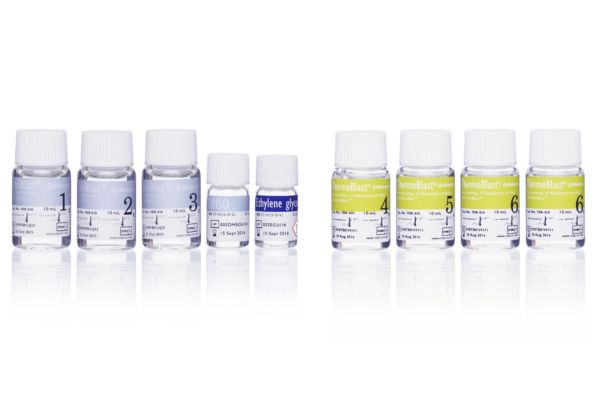Nidacon ThermoBlast Kit (4×10 ml)
Based on clinically tested, well established, standard formulations.
Nidacon’s VitriBlast and ThermoBlast vitrification media are based on well-tested standard formulations (Lane et al) and are both optimised for the vitrification of blastocysts. Since these products have been used in practice for a considerable time and thoroughly tested, Nidacon can provide detailed protocols for vitrifying blastocysts, ensuring the most reliable and secure process possible.
Why Vitrification?
The main challenge when freezing cells is the formation of intracellular ice crystals during both the cooling and rewarming process. These ice crystals have a detrimental effect on cell survival. Vitrification, the extremely rapid freezing of cellular material, makes it possible to freeze cells without ice crystals forming within the cells. T
Vitrification produces an amorphous crystalline structure, very homogenous in nature, much like glass and obsidian, which has sharp edges and smooth surfaces (glass transition), and which, like these materials, fractures easily. The cryoprotectants used for vitrification are a combination of Dimethyl Sulfoxide (DMSO), Ethylene Glycol, Sucrose, and Ficoll. Nidacon’s vitrification fluids, VitriBlast for cooling and ThermoBlast for warming/thawing, can both be used with various types of vitrification-devices, but for best results we recommend our own proprietary, closed system device.
Why Nidacon Vitrification?
VitriBlast and ThermoBlast are based on extensive clinical tests and use standardized formulations (Lane et al). Numerous publications have demonstrated the effectiveness of these formulations on both blastocyst survival and pregnancy rates. In addition, follow-up studies have been carried out on live-births, comparing new-births from fresh blastocysts with slow-frozen early cleavage stage embryos and vitrified blastocysts (Wikland M et al. (2010).
Which vitrification device should I use?
One should always use a legally marketed and certified device that is indicated for use in blastocyst vitrification procedures. Use a closed system to prevent the potential risk of viral contamination that comes with using open systems where the sample comes in direct contact with the liquid nitrogen. The device must meet the following cooling standards: minimum 1.800ºC/min (High security straw).
Clinical results
The formulation used in VitriBlast and ThermoBlast has been used at the Fertility Centre at Carlanderska Hospital in Gothenburg, Sweden since 2005 with excellent results. Blastocyst survival rates are slightly higher at ca. 5% (84% vs 80%) and pregnancy rate per transfer is much higher (54% vs 37%), when compared to the slow-freezing technique for cleavage stage embryos.

